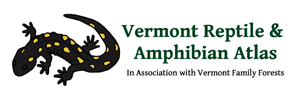Herp Update: indoors, in the snow, and funding request – February 25, 2021
Herpers, as you would expect herp reports at this time of year have been few and far between, but we did receive a photo of the Gray Tree Frog in Bridport that came in with a house plant. The frog has now been named Chuck and gets and he gets a few meal worms every other day. He will be put back outside when the temperatures warm back up. Scott Darling reports that Chuck calls every day.
We also received a report of a Spotted Salamander found dead on a snowy trail in Fairfax. Whether the salamander was disturbed by humans or predators, or motivated to move by the warmer weather we don’t know. That said, spring amphibian migration is not far away now. My wife is boiling sap on our wood stove as I type. Spring migration is closely associated with the end of sugaring season. Nighttime temperatures above freezing are needed for the amphibians and nighttime temperatures below freezing are needed for good sap runs, so on the last days of sap collection, Wood Frogs can often be heard. That is the origin of the term “frog run” for the last collection of sap.
So, from now on, conditions can change quickly. When we start seeing some patches of open ground, some melting around the edges of ponds and vernal pools, nighttime temps above freezing, and some rain, amphibians will be on the move from their overwintering locations in the woods to their breeding ponds and vernal pools. Wood Frogs are the first of the frogs to migrate, and Blue-spotted and Jefferson Salamanders are the earliest of the salamanders to move. The amount of ground exposed (and thawed), the amount of rain, and the temperatures all make a difference in the numbers of amphibians and numbers of species that will move. “Big nights” occur when there is lots of ground showing, temps soaring into the upper 40’s, and lots of rain to soak the exposed ground. That said, I have seen Blue-spotted Salamanders moving here in the Lake Champlain Valley with temperatures at 32°F and a wet snow falling. The snow was sticking to the backs of the salamanders as they moved.
Here in the banana belt of Vermont (the Lake Champlain Basin) we still have an even covering of about a foot of packed snow. But that could disappear fast with some rain. Migration could begin in two weeks, or be delayed another four weeks. At higher elevations, on north facing slopes, and further north in the state, it may be 4-6 weeks before the ground starts showing.
Our annual fundraiser is going well. We have raised over $11,000 toward our goal of $20,000. If you have donated already, thanks! If not, please consider it. The link to our fundraiser is posted below. You will see that you can contribute through GoFundMe, PayPal, or by writing and sending checks.
Jim Andrews
Our annual fundraiser has begun. For details please visit:
https://www.gofundme.com/f/vermont-reptile-amphibian-atlas-fundraiser-21

